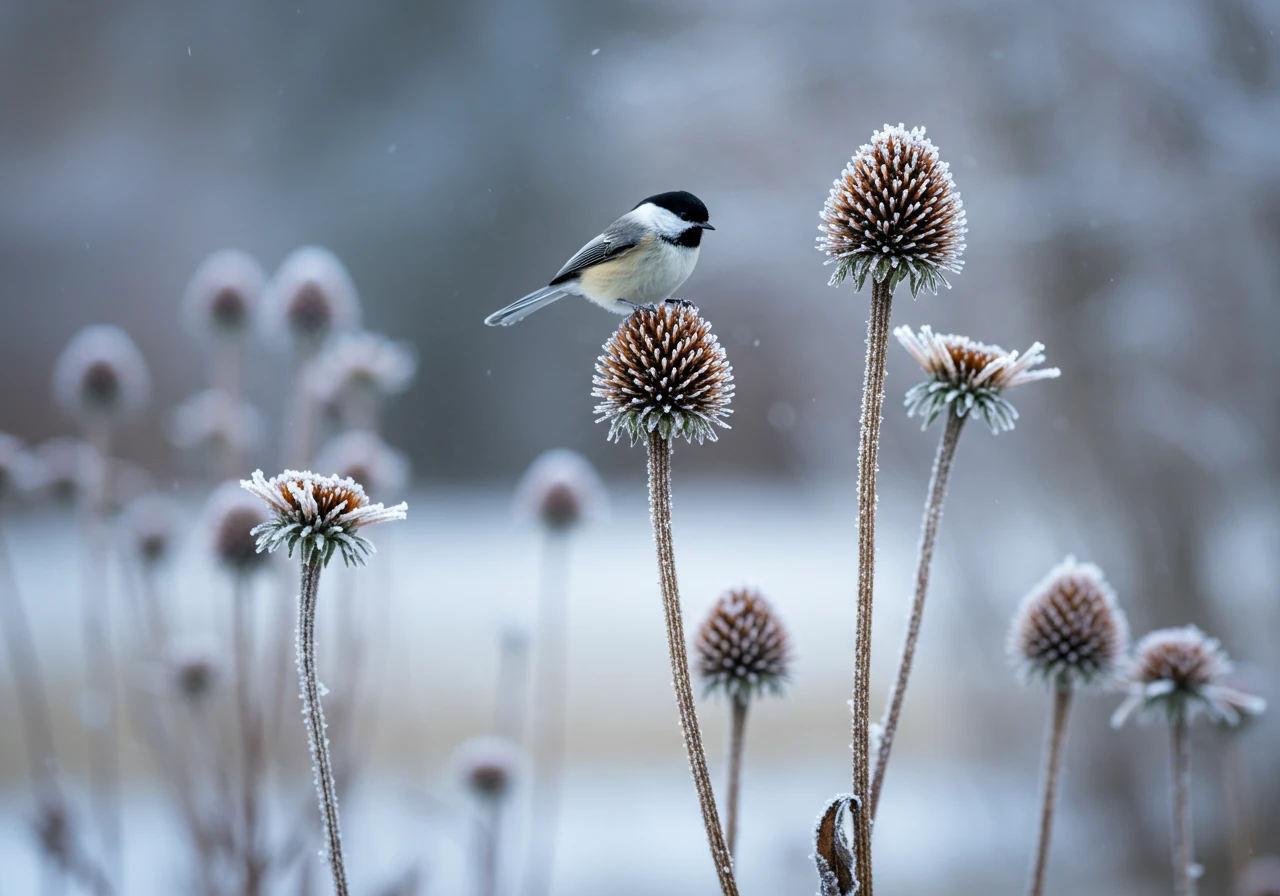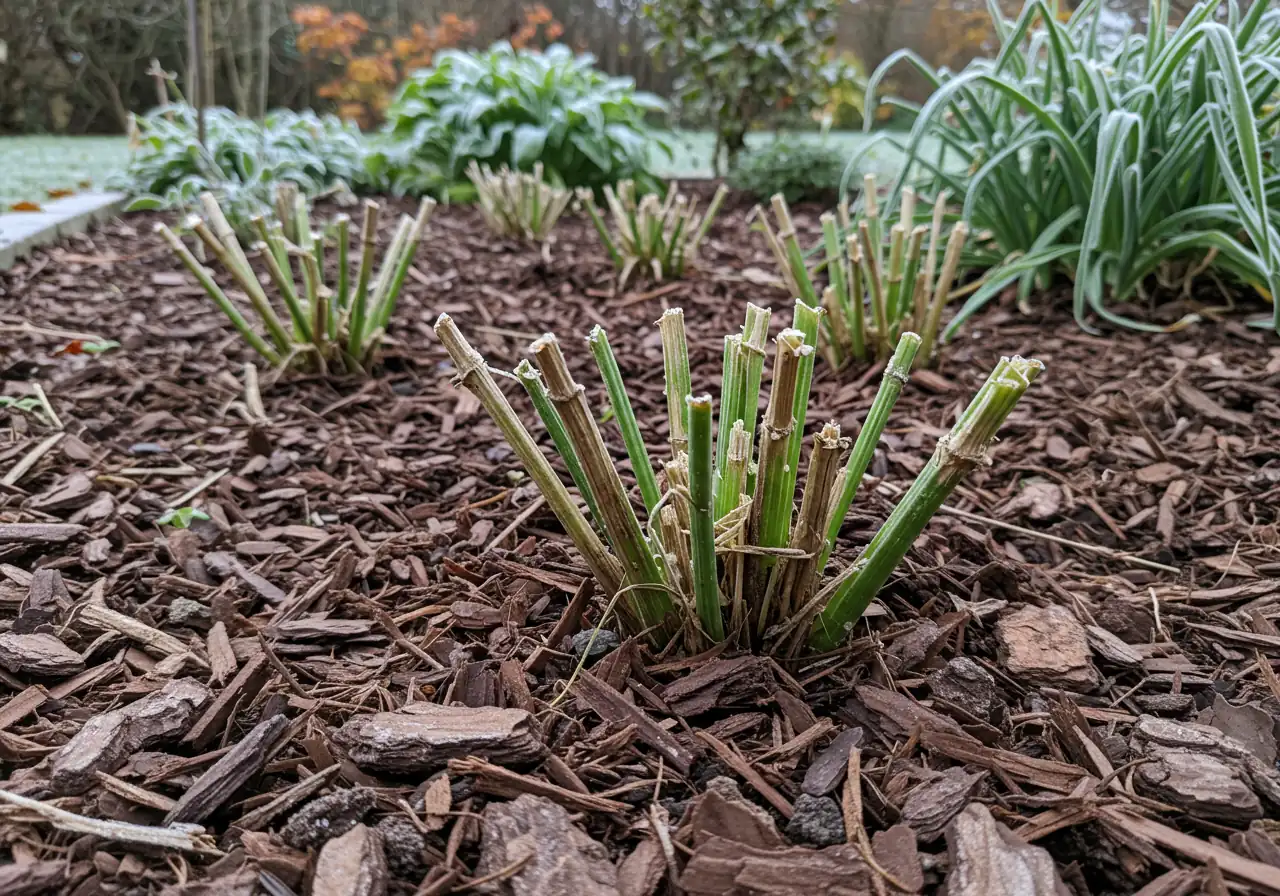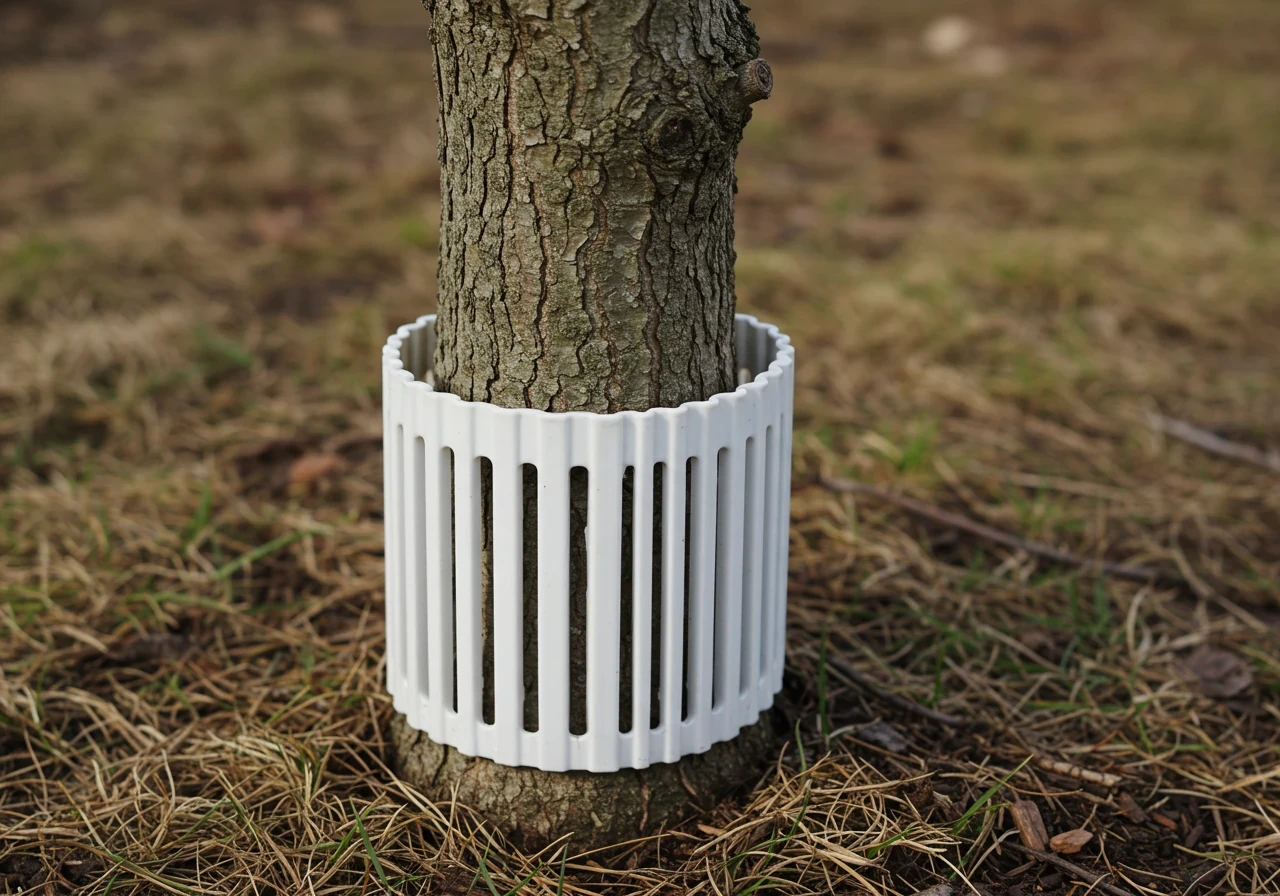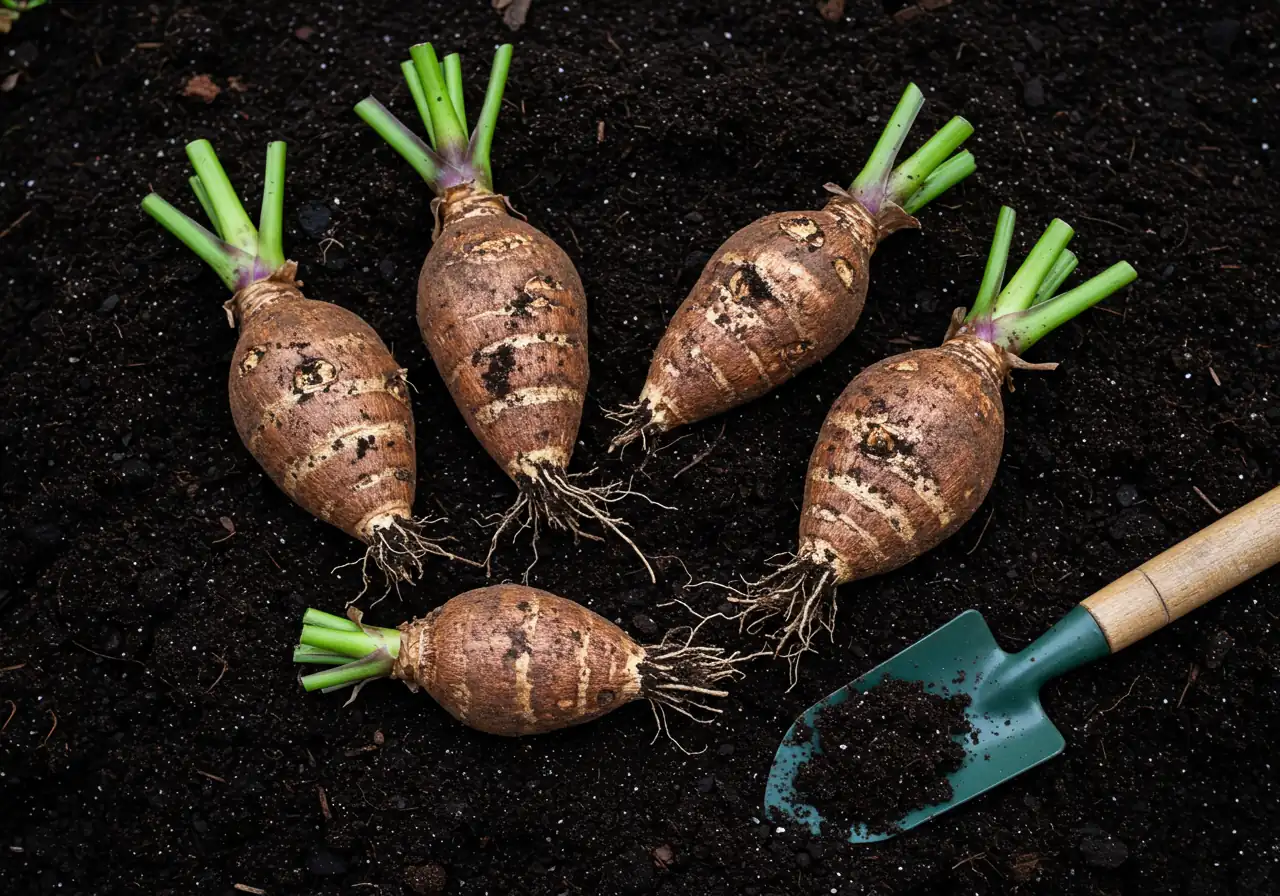Expert Kenmore Fall Guide: Plant Lifecycle Winter Prep
Quick Winter Prep Overview:
- Understand plant lifecycles (annual, perennial, woody) to tailor fall care.
- Address Ottawa's specific challenges: frost, clay soil, freeze-thaw cycles, snow load, salt.
- Cut back most perennials, but leave some for winter interest.
- Plant spring bulbs in fall; protect tender bulbs by digging and storing.
- Water trees/shrubs deeply before ground freeze; protect young trunks.
- Clean up veggie patches and amend soil or plant cover crops.
- Apply mulch after ground cools to insulate against temperature swings.
Introduction: Brrr-ace Yourselves! Your Kenmore Guide to Happy Winter Plants
Ah, Ottawa in the fall! Glorious reds, golds, and oranges paint the landscape... quickly followed by that familiar feeling: winter is *definitely* coming. Before we're all swapping rakes for shovels across Kenmore and neighbouring spots like Greely, it's crucial landscaping and gardening time for our green friends. It’s tempting to just admire the autumn show, but a little prep now means healthier, happier plants emerging next spring.
Why bother with winterizing? Well, surviving our specific climate isn't always a walk in the park (especially a frozen park!) for every plant. Understanding their *natural lifecycles* – whether they're hardy perennials that die back gracefully or shrubs needing protection from icy winds – is the secret to successful winter gardening in our region. Different plants, from towering trees to delicate roses, have different needs. Check out some examples of thriving landscapes in our Transformations Gallery.
Don't fret! We're here to help you navigate the "brrr" with practical tips. This guide will provide actionable advice to tuck your garden in safely, ensuring it’s ready to rebound beautifully when the warmth returns. Let's get your landscape ready to face the freeze! Need professional guidance? Feel free to contact us.
Decoding Ottawa's Autumn: Why Your Garden Needs a Winter Strategy
Okay, let's dive into *why* your garden needs a winter game plan here in the Ottawa area. Our autumns are gorgeous, shifting from vibrant colours to frosty mornings faster than you can say "pumpkin spice." But this transition brings specific challenges for your plants, whether you're gardening in Nepean, tending a lawn in Richmond, or anywhere in between.
First up: the *frost*. Ottawa typically sees its first killing frost sometime in late September or early October. Think of it as Mother Nature’s first cold slap – it signals the end for tender annuals and tells perennials it’s bedtime. Plants caught off guard can suffer serious damage. You can check the local forecast via resources like Environment Canada Weather Ottawa.
Then there's our *soil*. Much of the Ottawa region features heavy clay soil. While fertile, clay holds a *lot* of water. When winter hits, this waterlogged soil freezes solid, squeezing plant roots and potentially causing damage. It also thaws slowly in spring. Improving drainage and soil structure is key, which is why timing things like aeration correctly is so important. You can learn more about Greely Lawn Aeration Best Time Expert Advice.
Next challenge: the dreaded *freeze-thaw cycle*. Ottawa winters aren't always consistently freezing. We get thaws, then refreezes. This constant expansion and contraction of the soil can literally heave smaller plants and shallow-rooted perennials right out of the ground, exposing their roots to drying winds and deadly cold. Applying a protective layer can make a big difference, as discussed in these Metcalfe Mulch Magic Expert Installation Tips. Understanding the local watershed from sources like the Rideau Valley Conservation Authority can also provide context.
Don't forget the *snow load*. That beautiful blanket of snow can get heavy, especially the wet, sticky stuff. It can snap branches on shrubs and trees, particularly evergreens that catch a lot of it. Choosing hardy varieties and proper planting techniques are vital; check out some insights with these Richmond Tree Planting Tips Healthy Growth.
Finally, *salt damage* is a real issue near roads, driveways, and sidewalks. Salt spray and runoff can burn foliage and harm roots. Protecting vulnerable plants or choosing salt-tolerant species for those areas is wise.
Facing these challenges head-on with a good fall strategy means less winter damage and a healthier garden come spring. It's about giving your plants the best chance to survive and thrive after enjoying those last cozy evenings outdoors, perhaps gathered around a warm fire pit as detailed in these Barrhaven Fire Pit Design Fall Tips Ottawa. If tackling all this sounds like a bit much, exploring professional Landscaping and Yard Maintenance Services can ensure your garden gets the expert care it needs.
Plant Lifecycle 101: Who Needs What Before Winter Hits?
Ever wonder why some plants vanish after one season while others pop back up like clockwork? It's all about their natural lifecycle! Understanding this helps you figure out who needs a cozy winter blanket and who's perfectly fine roughing it through an Ottawa winter. Let’s break down the plant party guests and their pre-winter needs, whether you're gardening in Greely or elsewhere nearby.
- Annuals: These are the "live fast, die young" crowd of the plant world (think petunias, marigolds, zinnias). They complete their entire lifecycle – from seed to flower to seed – in a single growing season. Once a killing frost hits, they're done. Fall Action: Pull them out! Leaving dead annuals can invite disease and pests. This cleanup is a fundamental part of getting your yard ready for winter, and if the task list feels long, consider options like a professional Vernon Yard Cleanup Service or similar support like our Metcalf Yard Cleanup Service tailored to your neighborhood.
- Perennials: The comeback kids! These plants live for multiple years (think hostas, daylilies, peonies, coneflowers). Their roots survive underground while the top growth often dies back after frost. Fall Action: Most perennials benefit from being cut back to a few inches above the ground after a hard frost. This tidies the garden and helps prevent pests or diseases from overwintering in the dead foliage. A layer of mulch (like shredded leaves or straw) helps protect their crowns from harsh freeze-thaw cycles. Learn more about Garden Maintenance strategies.
- Biennials: These plants follow a two-year plan (like foxgloves, Sweet William, Canterbury bells). Year one is focused on growing leaves and strong roots; year two brings flowers and seeds, after which the plant usually dies. Fall Action: For first-year biennials, focus on protecting the leafy growth. Don't cut them back! A layer of mulch is beneficial.
- Woody Plants (Trees & Shrubs): These are the structural backbone of your landscape, the long-term residents. They have woody stems that survive winter above ground. Fall Action: Ensure they get a deep watering before the ground freezes solid, especially if the fall has been dry. Some younger trees or more sensitive shrubs (like certain evergreens or roses) might need protection like burlap wrap or tree guards to prevent winter burn or damage from hungry critters. You can get ideas for how this looks by browsing our Project Inspiration Gallery. Major pruning is often best left for late winter/early spring, but removing dead or damaged branches is okay now. Our Google Business Profile often features seasonal tips.
- Bulbs: Think of bulbs (tulips, daffodils, hyacinths, garlic) as little underground lunchboxes, storing all the energy needed to survive winter and burst forth in spring or summer. Fall Action: Fall is the *ideal* time to plant spring-blooming bulbs! For bulbs already in the ground, ensure the area has decent drainage. Adding a light layer of mulch after the ground starts to cool can offer insulation. Careful consideration of topdressing is part of smart Landscaping Material Selection Know-How. New garden designs might incorporate bulbs from the start; see our Garden Installation Services.
What Exactly is Dormancy?
You'll hear "dormancy" mentioned a lot. Think of it as plant hibernation. As daylight decreases and temperatures drop, many perennials and woody plants slow their metabolism way, way down. They stop actively growing and conserve energy in their roots or woody parts to survive the cold, often dry, winter conditions. They aren't dead, just taking a well-deserved nap!
Simple Fall Prep Cheat Sheet:
| Plant Type | Basic Fall Action | Why? |
|---|---|---|
| Annuals | Remove after frost | Won't survive winter; prevents disease/pests |
| Perennials | Cut back (most types), Mulch | Tidy appearance, pest prevention, root protection |
| Biennials | Mulch first-year plants, Don't cut | Protect leaves needed for Year 2 flowering |
| Woody Plants | Water deeply before freeze, Protect PRN | Ensure hydration, prevent winter burn/damage |
| Bulbs | Plant spring-bloomers, Mulch lightly | Establish for spring, provide insulation |
Understanding these basic lifecycles makes fall gardening tasks much more logical – and less like a guessing game! If mapping out all the steps and getting it done before the snow flies seems daunting, exploring professional Landscaping and Yard Maintenance Services can take the load off your shoulders. We believe in clear communication from the start; just check out our approach to Client Feedback on Estimates and Service. Knowing *who* needs *what* is the key to helping your garden bounce back beautifully next spring!
Fall Focus Areas: Key Tasks
Perennials & Bulbs Prep
Focus on cutting back most dead perennial foliage after frost, leaving some stems for winter interest (e.g., coneflowers). Plant spring-blooming bulbs like tulips and daffodils now. Consider dividing overcrowded perennials. Apply mulch after the ground cools to insulate against freeze-thaw.
Tree & Shrub Care
Ensure deep watering before the ground freezes, especially for evergreens and new plantings. Protect young tree trunks with guards against sunscald and animals. Use burlap screens for vulnerable evergreens in windy spots. Remove dead or broken branches, but save major pruning for late winter.
Garden Bed Cleanup & Soil Health
Remove all spent annuals and vegetable plants, including roots, to prevent pests/diseases. Clear fallen leaves and debris from beds. Amend soil by adding compost. Consider planting cover crops like fall rye in veggie patches to prevent erosion and add nutrients.
Putting Perennials & Bulbs to Bed: A Step-by-Step Guide


Alright, garden fans, the show isn't *quite* over yet! While the annuals might be taking their final bow, our trusty perennials and future spring bulbs need a little TLC before the curtain drops and the Ottawa winter truly sets in. Think of it as tucking them in with a warm blanket… made of soil and mulch, of course. Here’s how to get your perennials and bulbs ready for their long winter nap, step-by-step:
Step 1: The Great Cut-Back Debate
After a few good frosts have knocked back your perennial foliage (it’ll look limp and blackened), it’s generally time to trim.
- Why Cut Back? Tidiness is one reason – prevents a soggy mess come spring. More importantly, removing dead leaves gets rid of potential hiding spots for pests or diseases looking for a cozy winter home. Think hostas, peonies, daylilies – cut stems down to about 2-4 inches from the ground.
- Hold On Though! Not everything needs a crew cut. Plants with sturdy stems and interesting seed heads (like Coneflowers, Sedum 'Autumn Joy', ornamental grasses) can provide vital food for birds and look quite fetching dusted with snow, adding *winter interest* to your landscape, especially lovely in areas like Manotick. Consider leaving these standing until early spring. You decide the balance between tidy and wildlife-friendly! Learn more about garden care with services like our Marionville Garden Clean Up Service.
Step 2: Divide and Conquer (Maybe!)
Is your clump of Hostas looking more like a small country? Are your Daylilies staging a hostile takeover of the garden bed? Fall *can* be a good time to divide *some* spring and summer-blooming perennials (like the aforementioned Hostas, Daylilies, Peonies, Siberian Iris) after they've finished flowering and the weather cools.
- How? Carefully dig up the entire clump. Gently tease or use a sharp spade/knife to split the clump into smaller sections, ensuring each has healthy roots and shoots/buds. Replant them at the same depth, water well, and voila! More plants! (This might even free up space if you're considering New Sod Installation Sodding Services next year to redefine lawn edges). However, note that many gardeners prefer spring division for faster recovery on most plants. If unsure, a quick search for your specific plant is best.
Step 3: Bulb Planting Party!
Want a dazzling explosion of colour next spring? Fall is prime time for planting spring-blooming bulbs like tulips, daffodils, hyacinths, crocuses, and even garlic!
- Timing is Key: Aim to plant when average nighttime temperatures consistently dip to 4-10°C, usually 6-8 weeks before the ground freezes solid. In the Ottawa region, including areas like Kars and Osgoode, this often means late September through October, sometimes into early November if autumn is mild. A simple visual aid? Mark "Bulb Planting Window" on your calendar from mid-Sept to late Oct!
- Depth Matters: The general rule is to plant bulbs pointy-end-up at a depth three times their height. So, a 2-inch tulip bulb goes 6 inches deep. Follow package instructions if available.
- Location, Location: Plant in well-draining soil (bulbs hate wet feet, especially in winter!) and where they’ll get adequate sun in the spring. Check with local resources like the Ottawa Horticultural Society for tips specific to our region.
Step 4: Tuck Them In with Mulch
Once the ground has started to cool significantly (late October/November is often ideal), apply a layer of mulch 2-4 inches deep over your perennial beds and where you’ve planted bulbs.
- Why Mulch? In our Ottawa climate, the main goal isn't really warmth, but *insulation* against the damaging freeze-thaw cycles that can heave plants out of the ground. Shredded leaves, straw, or bark mulch work well. See our guide on Mulching and Edging.
- Technique: Don't pile mulch right up against the base of perennial crowns or stems, as this can trap moisture and invite rot or pests. Leave a little breathing room.
Step 5: Final Sweep and Sip (of Water!)
Do one last cleanup of fallen leaves or debris around your perennials. Give everything, especially newly planted bulbs and divided perennials, one last deep watering *before* the ground freezes solid, particularly if the fall has been dry.
Feeling overwhelmed by the list? Getting your garden ready for winter is crucial, but it doesn't have to be stressful. If you'd rather leave the heavy lifting to the pros, you can always Book An Estimate Today for fall cleanup services. We pride ourselves on clear communication and results, as reflected in our Client Feedback on Estimates and Service. For existing clients, managing your services is easy through the Clean Yards Customer Portal. And remember, comprehensive help like our Marionville Property Cleanup Service covers many of these tasks, ensuring your plants are snug and ready for spring!
Fall Garden Prep Timeline (Illustrative)
Late Sept / Early Oct
First frost watch! Begin cleanup of tender annuals. Assess perennials. Start planting spring bulbs. Consider lawn aeration.
Mid-October
Continue bulb planting. Cut back most perennials after foliage dies back. Divide perennials if needed. Rake leaves off lawn. Deep water trees/shrubs if dry.
Late Oct / Early Nov
Apply winter mulch once ground cools. Install tree guards/wraps. Ensure hoses are drained and stored. Final garden bed cleanup. Complete leaf removal.
Before Hard Freeze
Ensure all deep watering is complete. Check protective wraps. Store tender bulbs. Clean and store tools. Plan for next spring's garden installations!
Winter Armor for Trees & Shrubs: Protecting Your Woody Wonders

Okay, let's talk about the big guys in your yard – the trees and shrubs. They're the structural stars of your landscape, and while many are tough cookies, our Ottawa winters can throw some serious curveballs. Giving them a little "winter armor" now means they'll be ready to leaf out and flower beautifully next spring, instead of looking like they barely survived a battle. Discuss your tree needs when considering our about us page and services.
First things first: Hydration! Before the ground freezes solid (usually sometime in late October or November), give your trees and shrubs, *especially* evergreens and any newly planted specimens, a really deep drink. Winter winds can dry out foliage (winter burn!), and if the ground is frozen, the roots can't replace that lost moisture. Think slow and steady – let a hose trickle at the base for a good long while, soaking the root zone deeply. This is way more effective than a quick sprinkle. Proper watering supports the entire ecosystem of your yard, complementing other essential tasks like fall Lawn Care.
Next up: Trunk protection. Young trees, fruit trees, and those with thin bark (like maples or lindens) are susceptible to a couple of winter woes:
- Sunscald & Frost Cracks: On bright, sunny winter days, the sun can warm up the south/west side of the trunk. When temperatures plummet at night, the rapid freeze-thaw cycle can cause the bark to split vertically. Not fun! Wrapping the trunk with light-colored tree wrap or installing plastic tree guards from the base up to the first branches helps reflect sunlight and moderate temperature swings.
- Critter Buffet: Hungry rabbits and voles see tender young bark as a winter snack bar, especially when snow cover is deep. In areas like Barrhaven or Winchester where wildlife might be more common neighbours, this is crucial. Protective plastic guards or even wire mesh cylinders around the base are your best defense against girdling (when critters chew bark all the way around, which can kill the tree).
Evergreens need special attention too. Their needles lose moisture to winter winds, leading to that dreaded brown, crispy look known as winter burn.
- Burlap Windbreaks: For vulnerable evergreens (like cedars, yews, or dwarf Alberta spruce) in exposed locations, consider creating a windbreak. Drive stakes into the ground *before* it freezes and wrap burlap around them, leaving a gap between the burlap and the plant for air circulation. Don't wrap the plant directly like a mummy! This is especially helpful near roads where salt spray adds extra stress.
- Anti-Desiccant Sprays: These waxy sprays can help reduce moisture loss from needles. Follow product instructions carefully; they usually need to be applied when temperatures are above freezing.
What about pruning? Generally, hold off on major tree and shrub pruning in the fall. Pruning can encourage new growth that won't have time to harden off before winter hits. However, it *is* okay to remove any dead, diseased, or broken branches now – think of it as basic first aid. Save the serious shaping for late winter or early spring.
Taking these steps might seem like extra work during a busy fall cleanup season. Tasks like leaf removal and garden tidying are also essential – services like our Metcalf Garden Clean Up Service or the comprehensive Marionville Yard Cleanup Service handle many of these chores. If adding tree and shrub protection feels like too much, don't hesitate to reach out. You can easily Book An Estimate Today to discuss your specific landscaping needs. Investing a little time or professional help now means your woody wonders will emerge stronger and healthier, ready to impress next season. Trust us, they'll practically give you a big Thank You! come spring!
Mulch Benefits: Reducing Winter Soil Heave (Illustrative Chart)
Note: Chart is illustrative. Actual effectiveness varies based on mulch type, depth, soil, and weather conditions.
Tidying the Veggie Patch & Handling Tender Plants

Alright, let's talk about the spots that gave us so much joy (and maybe zucchini overload) this summer: the vegetable garden and annual flower beds! As the Ottawa fall chill sets in, it’s tempting to just walk away, but a proper cleanup now is your secret weapon against pests and diseases next year. Think of it as giving the garden a good scrub-down before winter hibernation.
First things first: *eviction notice* for spent plants! Pull out all those finished annual flowers (marigolds, petunias, etc.) and veggie plants (tomatoes, beans, squash vines – yes, even the zucchini monster). Don't just chop them at the base; remove the roots too. Leaving dead plant matter behind is like rolling out the welcome mat for fungal diseases and overwintering insects. Get rid of *all* the fallen leaves and rotten veggies, too. This thorough removal is a key part of any good complete property clean up. If you had disease issues (like tomato blight), don't compost that specific plant debris – bag it up for municipal pickup (check City of Ottawa Waste Explorer) to avoid spreading problems.
Once the beds are clear, show your soil some love! Autumn is the perfect time for *soil amendment*. Spreading a layer of compost over the veggie patch or annual beds adds vital organic matter and nutrients. You can gently fork it into the top few inches or just let the winter weather work it in. Another fantastic, eco-friendly option is planting *cover crops* like oats or fall rye. These "green manures" grow quickly in the cool weather, preventing soil erosion from harsh winter winds and rain, suppressing weeds, and adding nutrients back when tilled in next spring. It’s like a cozy, useful blanket for your soil! Learn about Soil Preparation best practices.
Now, what about those gorgeous but sensitive plants like dahlias, cannas, gladioli, and tuberous begonias? These are *tender bulbs* (or tubers/corms) and won't survive our freezing Ottawa ground.
- Wait until the first hard frost blackens their foliage. This tells the plant to send energy down to the bulb/tuber.
- Carefully dig them up, trying not to damage them. Gently shake off excess soil.
- Let them *cure* (dry) for a few days to a week in a cool, airy place away from direct sun (like a garage or shed).
- Store them in boxes or crates filled with slightly damp peat moss, sawdust, or vermiculite. Keep them in a cool, dark, frost-free spot (around 5-10°C is ideal). Check them occasionally over winter for rot or shriveling.
Finally, don't forget your tools! Clean off any soil, maybe give them a quick wipe with an oily rag to prevent rust, and store them somewhere dry. Sharp, clean tools make gardening much easier (and safer!).
Taking care of these tasks now sets you up for a healthier, more productive garden next spring. Doing this cleanup now prevents headaches later – a future Thank You! from you to you! If the job feels too big, especially if you're in areas like Metcalfe, remember that professional help like a specific Metcalf property cleanup service or a more general Ottawa property cleanup service can handle the heavy lifting. Getting your entire space ready might even call for a comprehensive Ottawa yard cleanup service to ensure everything is tucked in properly before the snow flies.
HIGHLIGHT BOX: Kenmore's Quick Fall Prep Checklist
Feeling the autumn crunch time here in Kenmore? Don't let fall garden chores bury you like the leaves! Here's a quick hit list to get your yard ready for its winter nap without breaking your back (or your spirit).
- Leaf Wrangling & Lawn Love: Rake or blow those leaves off the lawn! Too many leaves can smother your grass over winter. Compost them if you can, or bag 'em up. Giving your lawn a final cut, maybe a bit shorter, helps too. Tackling the whole yard feeling like a mountain? Consider a thorough Ottawa yard cleanup service to handle the heavy lifting.
- Perennial Pampering: Cut back *most* dead perennial foliage after a frost (leave some sturdy seed heads like Coneflowers for winter interest and bird food!). Add a layer of mulch (like shredded leaves) around the base *after* the ground cools to protect roots from those wild Ottawa freeze-thaw cycles. Consistent care is part of good garden maintenance.
- Hydrate & Protect Trees/Shrubs: Give your woody friends, especially evergreens and young trees, a deep, slow watering before the ground freezes solid. Protect trunks of young, thin-barked trees from sunscald and critters with tree wrap or plastic guards. A little shield goes a long way!
- Veggie Patch Vacate & Bulb Bonanza: Clear out all the spent veggie plants and annual flowers – roots and all – to prevent pests and diseases from overwintering. Plant those spring-blooming bulbs (tulips, daffodils) now for a colour explosion next year!
- Tool Time & Final Sweep: Clean your garden tools thoroughly before storing them for winter – scrub off dirt and maybe wipe metal parts with an oily rag to prevent rust. Do one last walk around the yard, putting away hoses, furniture, and any stray garden gnomes looking for trouble.
This checklist covers the basics to tuck your Kenmore or nearby Manotick garden in safely. Got questions or need a hand making it happen before the snow flies? Don't hesitate – feel free to contact us. When you reach out, we respect your details; you can see our commitment to your privacy outlined clearly. Let's get your yard winter-ready!
FAQs: Your Ottawa Winter Gardening Questions Answered
Great question! Ideally, you want to apply winter mulch *after* the ground has started to cool down significantly, often late October or November, but *before* it freezes solid. Applying it too early can keep the soil too warm, confusing plants. But if you’re running behind, getting a layer down even just before a deep freeze is better than nothing! It helps prevent that damaging freeze-thaw cycle. Proper Mulching and Edging Techniques are key to protecting roots without smothering crowns, especially important in areas like Embrun facing harsh winds.
Not necessarily! While cutting back most perennials like hostas or daylilies helps prevent disease and pests from overwintering, some plants offer great winter interest and food for birds. Think sturdy seed heads on Coneflowers or ornamental grasses – they look lovely dusted with snow in a Winchester garden! Leaving a few standing adds structure. However, removing soggy, diseased foliage is always a good idea. If cleanup feels overwhelming, consider a professional Reliable Ottawa Garden Clean Up Service to handle the tidying.
Ah, clay soil – holds moisture like a champ, which can be tricky in winter! The best thing you can do is add organic matter *now*. Spread a generous layer of compost over your garden beds after clearing out annuals and veggies. You can gently fork it in or just let winter work it. This improves drainage and prevents compaction. Good Effective Soil Preparation Methods in the fall make spring planting much easier and reduce issues like root heave caused by freezing water trapped in the clay.
It depends! In exposed, windy locations or spots near roads where salt spray is common (hello, busy streets!), wrapping vulnerable evergreens like cedars or yews with burlap can prevent winter burn (that ugly brown scorching). Use stakes to create a screen, don't wrap tightly against the plant. For younger trees or those in less harsh spots, ensuring they are well-watered before the ground freezes might be enough. It's about assessing the specific risk to your plants in your landscape.
Honestly, one of the biggest (and easiest to make!) mistakes is leaving thick layers of leaves matted on the lawn. While leaves make great mulch *in garden beds*, smothering your grass all winter invites snow mould and can kill patches of turf. Rake them up or mulch-mow them finely! Another common slip-up is forgetting that final deep watering for trees and shrubs before the ground freezes solid. Staying on top of these tasks makes a huge difference come spring. Always review service details, like our clear Terms and Conditions, before booking any help.
Conclusion: Tuck Your Garden In & Dream of Spring!
Whew! We’ve covered a lot of ground, haven't we? From wrestling leaves to giving your perennials a cozy blanket, getting your Ottawa garden ready for winter might seem like one last big chore before the snow flies. But trust us, taking these fall prep steps now is your secret weapon for a healthier, happier, and more vibrant landscape come spring. Think of it as giving your plants, whether in Kenmore, Manotick, or anywhere nearby, the best possible chance to survive our chilly winters and burst back to life beautifully. A little effort now prevents a lot of springtime sadness later!
So, go ahead, give your garden that final tuck-in. Get those bulbs planted, protect your precious shrubs, and clear out the old stuff. Then, you can *truly* kick back, maybe with a hot cocoa, and start dreaming of next year’s blooms.
Feeling like your fall to-do list is longer than a winter night? Or maybe you just want the peace of mind that comes with professional care? No problem! We’re here to help residents in Kenmore and the surrounding Ottawa areas get their landscaping ship-shape for winter. Whether it's a full fall cleanup like our Metcalf Property Cleanup Service, targeted plant protection, or getting those beds perfectly mulched, let us handle the heavy lifting.
- Ready for expert help? Book An Estimate Today and let's chat about your fall landscaping needs.
- Need more tips or info? Explore our Landscaping and Yard Maintenance Services or browse our Blog for more gardening wisdom.
Let's get your garden tucked in safely, so you can rest easy and dream of a spectacular spring!

